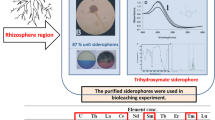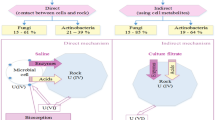Abstract
In this study, Arthrobacter luteolus, isolated from rare earth environment of Chavara (Quilon district, Kerala, India), were found to produce catechol-type siderophores. The bacterial strain accumulated rare earth elements such as samarium and scandium. The siderophores may play a role in the accumulation of rare earth elements. Catecholate siderophore and low-molecular-weight organic acids were found to be present in experiments with Arthrobacter luteolus. The influence of siderophore on the accumulation of rare earth elements by bacteria has been extensively discussed.

Similar content being viewed by others
References
Ahmed ZU, Shapiro S and Vining LC 1984 Excretion of α-keto acids by strains of Streptomyces venezuelae. Can. J. Microbiol. 30 1014–1021
Altschul SF, Madden TL, Schäffer AA, Zhang J, Zhang Z, Miller W and Lipman DJ 1997 Gapped BLAST and PSI-BLAST: a new generation of Protein database search programs. Nucleic Acids Res. 25 3389–3402
Anandkumar B, Rajasekar A, Venkatachari G and Maruthamuthu S 2009 Effect of thermophilic sulphate-reducing bacteria (Desulfotomaculum geothermicum) isolated from Indian petroleum refinery on the corrosion of mild steel. Curr. Sci. 97 342–348
Andres Y, Texier AC and Cloirec PL 2003 Rare earth elements removal by microbial biosorption: A review. Environ. Technol. 23 1367–1375
Andres Y, Thouand G, Boualam M and Mergeay M 2000 Factors influencing the biosorption of gadolinium by microorganism and its mobilization from sand. Appl. Microbiol. Biotechnol. 54 262–267
Arnow E 1936 Colorimetric determination of the components of 3, 4-dihydroxyphenyl-alanine-tyrosine mixtures. J. Biol. Chem. 118 531–537
Atkin CL, Neilands JB and Phaff H 1970 Rhodotorulic acid from species of Rhodospirillum, Rhodotorula, Sporidiobolus and Sporobolomyces. J. Bacteriol. 103 722– 733
Bayer ME and Bayer MH 1991 Lanthanide accumulation in the periplasmic space of Escherichia coli B. J. Bacteriol. 173 141–149
Beveridge TJ and Fyfe WS 1985 Metal complexation by bacterial cell walls. Can. J. Earth Sci. 22 1893–1898
Brantley S L, Liermann L, Bau M and Wu S 2001 Uptake of trace metals and rare earth elements from hornblende by a soil bacterium. Geomicrobiol. J. 18 37–61
Crosa JH and Walsh CT 2002 Genetics and assembly line enzymology of siderophore biosynthesis in bacteria. Microbiol. Molecular Biol. Rev. 66 223–249
Date AR and Gray AL 1985 Determination of trace elements in geological samples by inductively coupled plasma source mass spectrometry. Spectrochim. Acta B 40 115–122
Emmanuel ESC, Vignesh V, Anandkumar B and S Maruthamuthu 2010 Bioaccumulation of cerium and neodymium by Bacillus cereus isolated from rare earth environments of Chavara and Manavalakurichi, India. Indian J. Microbiol. 51 488–495
Fessenden RJ and Fessenden JS 1986 Organic Chemistry 3rd edition (Monterey, CA: Brooks and Cole)
Guerinot ML 1994 Microbial iron transport. Ann. Rev. Microbiol. 48 743–772
Henderson P 1984 General geochemical properties and abundances of the rare earth elements; in Rare earth element geochemistry (ed.) P Henderson (Amsterdam: Elsevier) pp. 1–32
Holt JG, Kreig NR , Sneath PHA, Staley JT and Williams ST 1994 Endospore forming Gram positive rods; in Bergey’s manual of determinative bacteriology 9th edition (ed.) WR Hensyl (Baltimore, MD: Williams and Wilkins) pp. 559–570
Jeya R, Balasubramanian G and Thampi PK 2008 Determination of rare earth elements in Indian coastal monazite by ICP-AES and ICP-MS analysis and their geochemical significance. Curr. Sci. 94 1296–1302
Kalinowski BE, Liermann LJ, Brantley SL, Barnes A and Pantano CG 2000 X-ray photoelectronspectroscopic evidence for bacteria-enhanced dissolution of hornblende. Geochim. Cosmochim. Acta 64 1331–1343
Kamijo M, Suzuki T, Kawai K and Murase H 1998 Accumulation of yttrium by Variovorax paradoxus. J. Ferment. Bioeng. 86 564–568
Kutzner HJ 1981 The family Streptomycetacae; in The Prokaryotes: A Handbook on habitats, isolation and identification of bacteria (eds.) MP Starr, H Stolp, HG Truper, A Balows and HG Schlegel (Berlin: Springer-Verlag ) pp. 2028–2090
Laemmli UK 1970 Cleavage of structural proteins during the assembly of the head of bacteriophage T4. Nature 227 680–685
Liermann LJ, Kalinowski BE, Barnes AS, Zhou X and Brantley SL 2000 Measurements of pH by microelectrodes in biofilms grown on silicate surfaces. Chem. Geol. 171 1–16
Martinez JS, Franklin JNC, Mann EL, Martin JD, Haygood MG and Butler A 2003 Structure and membrane affinity of a suite of amphiphilic siderophores produced by a marine bacterium. Proc. Natl. Acad. Sci. U.S.A. 100 3754–3759
Matzanke BF 1991 Structures, coordination chemistry and functions of microbial iron chelates; in CRC Handbook of microbial iron chelates (ed.) G Winkelmann (Boca Raton, FL: CRC Press) pp. 15–37
Merroun ML, Ben Chekroun K, Arias JM and Gonzalez-Munoz MT 2003 Lanthanum fixation by Myxococcus xanthus: Cellular location and extra cellular polysaccharide observation. Chemosphere 52 113–120
Meyer JM and Abdullah MA 1978 The fluroscent pigment of Pseudomonas fluroscens biosynthesis, purification and physical-chemical properties. J. Gen. Microbiol. 107 319–328
Morel FMM and Hering JG 1993 Principles and applications of aquatic chemistry (New York: Wiley)
Neilands JB 1981 Microbial iron compounds. Annu. Rev. Biochem. 50 715–731
Ozaki T, Suzuki Y, Nankawa T, Yoshida T, Ohmiki T, Kimura T, Arokiasamy and Francis J 2005 Interaction of rare earth elements with bacteria and organic ligands. J. Alloys Compounds 408 1334–1338
Reigh G and O’Connell M 1988 Siderophore production is strain specific in Rhizobium; in Nitrogen fixation: hundred years after (eds.) H Bothe, FJ DeBruijin and WE Newto (New York: Gustav Fischer) pp. 826– 839
Roane TM and Kellogg ST 1996 Characterization of bacterial communities in heavy metal contaminated soils. Can. J. Microbiol. 42 593–603
Roane TM, Reynolds KA, Maier RM and Pepper IL 2009 Microorganisms; in Environmental microbiology (eds.) RM Maier, IL Pepper and CP Gerba (New York: Academic Press) pp. 9–25
Rozycki H and Strzelczyk E 1986 Organic acids production by Streptomyces spp. isolated from soil, rhizospere and mycorrhizospere of pine (Pinus sylvestris L.). Plant Soil 96 337–345
Schwyn B and Neilands JB 1987 Universal chemical assay for the detection and determination of siderophores. Anal. Biochem. 160 47–56
Stone AT 1997 Reactions of extracellular organic ligands with dissolved metal ions and mineral surfaces. Rev. Mineral. Soc. Am. 35 309–344
Suryakala D, UmaMaheswaridevi P and Vijaya Lakshmi K 2004 Chemical characterization and antibiosis of siderphores of rhizosphere fluroscent Pseudomonads. Indian J. Microbiol. 44 105–108
Teske A, Hinrichs KU, Edgcomb V, Gomez AV, Kysela D, Sylva SP, Sogin ML and Jannasch HW 2002 Microbial Diversity of hydrothermal sediments in the Guaymas Basin: evidence for anaerobic methanotrophic communities. Appl. Environ. Microbiol. 68 1994–2007
Tsuruta T 2006 Selective accumulation of light or heavy rare earth elements using gram-positive bacteria. Colloids 52 117–22
Tyler G 2004 Rare earth elements in soil and plant systems - A review. Plant Soil 267 191–206
Urrutia MM, Kemper M, Doyle R and Beveridge TJ 1992 The membrane-induced proton motive force influences the metal binding ability of Bacillus subtilis cell walls. Appl. Env. Microbiol. 58 3837–3844
Walsh JN, Barker J and Buckley F 1981 Simultaneous determination of the rare-earth elements in rocks using inductively coupled plasma source spectrometry. Chem. Geol. 33 141–153
Wawer C and Muyzer G 1995 Genetic diversity of Desulfovibrio spp. in Environmental samples analysed by denaturing gradient gel electrophoresis of (NiFe) hydrogenase gene fragments. Appl. Environ. Microbiol. 61 2203–2210
Author information
Authors and Affiliations
Corresponding author
Additional information
[Challaraj Emmanuel ES, Ananthi T, Anandkumar B and Maruthamuthu S 2012 Accumulation of rare earth elements by siderophore-forming Arthrobacter luteolus isolated from rare earth environment of Chavara, India. J. Biosci. 37 1–7] DOI
Rights and permissions
About this article
Cite this article
Emmanuel, E.C., Ananthi, T., Anandkumar, B. et al. Accumulation of rare earth elements by siderophore-forming Arthrobacter luteolus isolated from rare earth environment of Chavara, India. J Biosci 37, 25–31 (2012). https://doi.org/10.1007/s12038-011-9173-3
Received:
Accepted:
Published:
Issue Date:
DOI: https://doi.org/10.1007/s12038-011-9173-3




